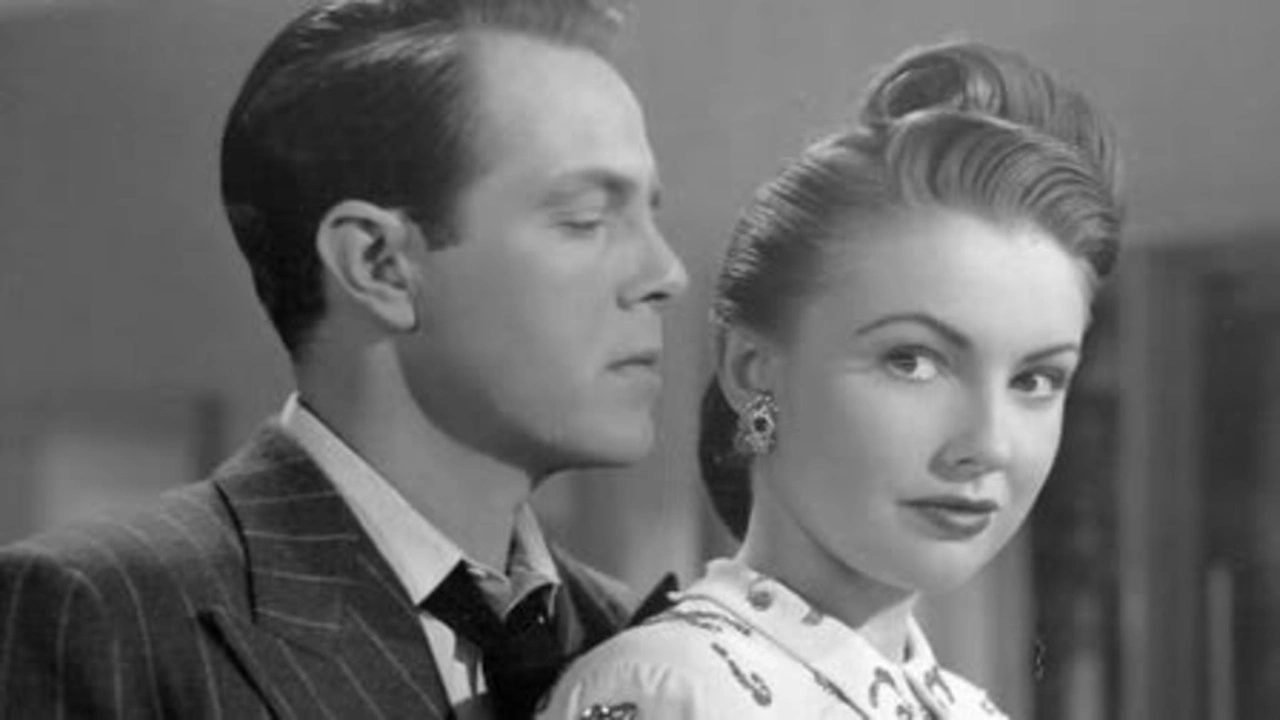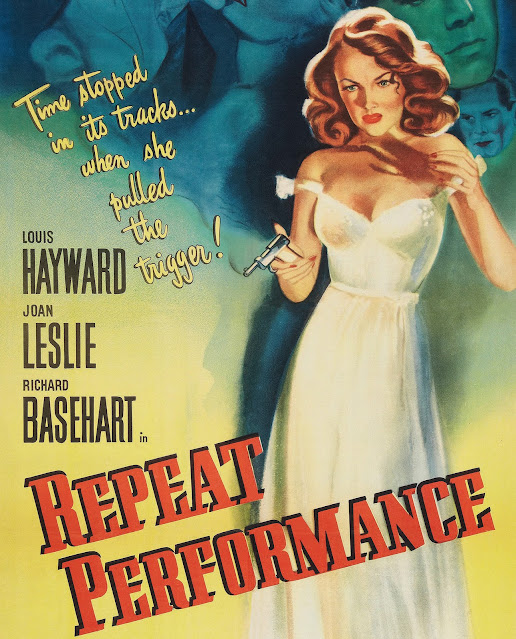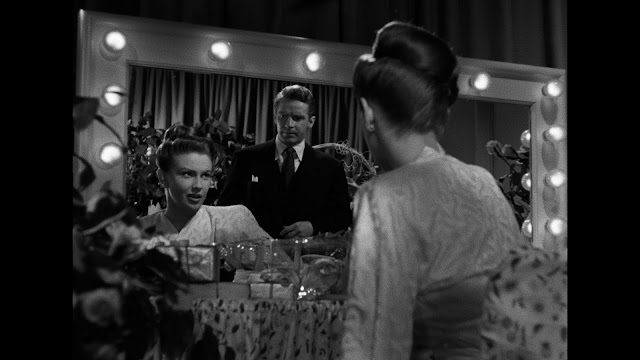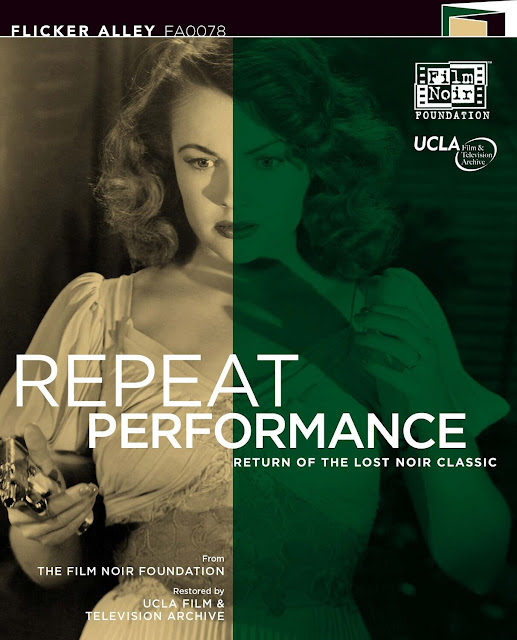

“Stars look down on New Year’s Eve in New York. They say that fate is in the stars. That each of our years is planned ahead. And nothing can change destiny. Is that true? How many times have you said ‘I wish I could live this year over again?’ This is the story of a woman who did relive one year of her life.”
Directed by Alfred L. Werker and based on a novel by William O’Farrell, Repeat Performance (1947) is a time travel noir that imagines a protagonist being given a second chance to change the course of events that led to a terrible tragedy. Joan Leslie plays Sheila Page, a celebrated actress married to playwright Barney Page (Louis Hayward). While Sheila’s career has gained momentum over recent months, Barney’s career is spiralling out of control due to his alcoholism and the lingering resentment he feels towards his more successful wife. The film starts on New Year’s Eve in 1946. As partygoers usher in 1947, Sheila is reeling from the fact that she has just shot and killed her abusive husband. She confides in her good friend William Williams (Richard Basehart in his screen debut), a poet and a member of Sheila’s social scene, wishing she could relive 1946 and ultimately alter the timeline that led her to this moment. Mysteriously both Sheila and William are transported back to New Year’s Eve 1945 and Sheila’s given a second chance. Can she prevent that fatal night from reoccurring or is she bound by the chains of destiny.
 |
| Joan Leslie and Richard Basehart in Repeat Performance (1947) |
In the article I wrote for TCM, I wrote “Repeat Performance (1947) is a flimsy noir bolstered by an intriguing conceit.” I’ll add to this that I found the film quite gratifying for several reasons. We get to see Joan Leslie in a robust leading role (instead of a supporting ingenue part). She is dressed to the nines in costumes by Oleg Cassini and jewelry (pay attention to the broaches!) by Eugene Joseff. Leslie is able to maintain some of her wholesome image playing a character who is a genuinely good person stuck in a bad situation. As someone who loves all things New Year’s, I love how the holiday is implemented in this story. It’s the perfect setting since this is a prime moment when we think about the events of the past year and plot out what we’ll do different in the next. I also really enjoy the fact that the way the plot plays out is not quite what you’d expect. I enjoyed the cast of characters including Tom Conway as John Friday, the smarmy theatrical producer, and Virginia Field as Paula Costello, a rival actress who tries to poison Barney’s mind against Sheila. The film also examines the social politics of the theatre world and Basehart’s character William Williams adds two interesting subthemes: literature and mental health.
There is one interaction between Leslie and Hayward that is blatantly sexist and a bit of a head scratcher. If you’ve watched the film, you’ll know exactly what I mean. It’s not strictly a noir but film noir expert Eddie Muller calls it a “noir fantasy” because of how the film blends noir with supernatural elements.
Repeat Performance was produced by Aubrey Schenck for Eagle-Lion Films Inc. Joan Leslie had just had a tumultuous falling out with her home studio Warner Bros. and was working as a free agent. Here is some more background on the film from my article:
“Now as a free agent, the star went to work for Eagle-Lion. Actress Constance Dowling had just left Eagle-Lion because of her own dissatisfaction with her roles and Leslie replaced her as the lead in Repeat Performance. Eagle-Lion was eager to showcase their new star and they elevated what would have been a low-budget film to a big budget production….
Repeat Performance didn’t make a splash back in 1947 but it continues to linger in the minds of generations of viewers who have seen it since. At the 2013 Seattle Noir City premiere of the film, Eddie Muller called the film a “film noir version of It’s a Wonderful Life (1946).” He went on to say that “over the years [many people] have told me about seeing Repeat Performance when they were young and it stuck in their mind. There is something about the premise of this film…” The introductory voiceover read by John Ireland and the conceit is also a memorable precursor to Rod Serling’s hit TV show The Twilight Zone. Repeat Performance has since been remade as the TV film Turn Back the Clock (1989) with Joan Leslie in a cameo role. Leslie was a featured guest at a 2011 Noir City event and by sheer luck a 16mm print purchased by a private collector was made available just in time for the screening. Bad prints of the film have circulated over the years and this newly discovered 16mm print was in much better condition.”
Repeat Performance (1947) is available in a deluxe DVD/Blu-ray set from Flicker Alley. The film was preserved by the UCLA Film and Television Archive in conjunction with The Film Noir Foundation and funded by The Packard Humanities Institute. The restoration is a sight to behold. I had only ever seen bad copies of the film and the Blu-ray edition was a sight for sore eyes.

Amazon — Barnes and Noble — Deep Discount — Flicker Alley
Flicker Alley’s release has a robust offering of extras. The jewel case includes two discs, a reversible cover and a booklet with photos and the article Repeat Performance: A Book-to-Film Comparison by Brian Light. The disc extras include an introduction by Eddie Muller, a promotional pressbook and audio commentary by Nora Fiore. My favorite extras by far were two vignettes: Farran Smith Nehme’s profile on Joan Leslie and Alan K. Rode and Steven C. Smith’s Eagle-Lion: A Noir Stained Legacy.
Thank you to Flicker Alley for sending me a copy for review!
